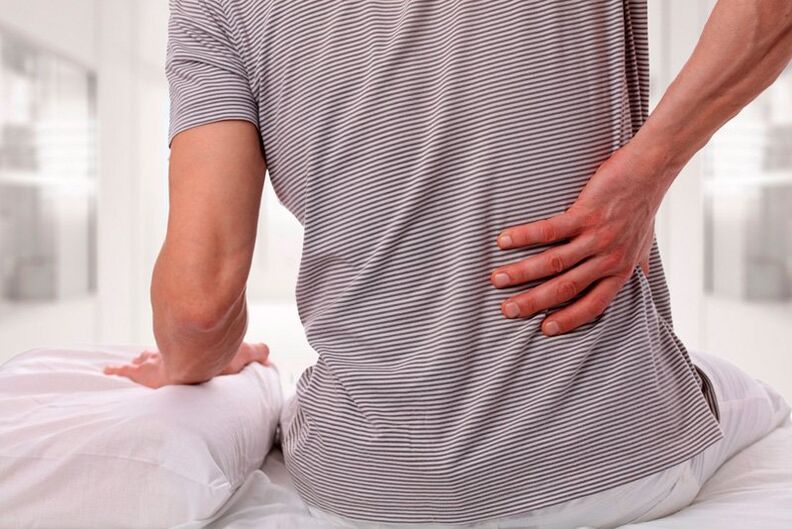Back pain (synonym for back pain) is one of the most common reasons to see a doctor-second only to acute respiratory disease 1. In most cases, such complaints will be made to a neurologist, therapist or general practitioner. According to international research, 19% to 43% of the adult population surveyed recently noticed back pain in the last month. Last year, the proportion went from 27% to 65%. 59-84% of people who have experienced this situation at least once in their lifetime 1. At this moment, almost every fifth adult on the planet will experience severe back pain. Their most common positioning is waist and waist.

Why does back pain occur?
The main causes of back pain include:
- Vertebral causes-related to spine pathology:
- Pathology of the intervertebral disc, including hernia;
- Narrowing of the spinal canal;
- Joint disease
- Consequences of injury;
- Congenital malformations and developmental abnormalities;
- Metabolic disorders;
- Spondylitis-the inflammatory process of the intervertebral joints.
- Nonvertebrogenic-not related to spinal pathology:
- Ligament and muscle sprains associated with heavy loads;
- Myofascial syndrome-chronic muscle pain;
- Inflammation of muscle tissue-myositis;
- Visceral diseases;
- Pathology of large blood vessels, for example, aneurysm of the abdominal aorta (rapid dilation);
- Hip arthropathy-a disease of inflammatory dystrophy;
- Mental disorders, etc.
According to the origin, the following types of pain can be distinguished:
- specific-Related to specific diseases that can be detected by standard inspection methods. This type accounts for at most 3% of all cases1. These may be spinal compression fractures, tumors, infection processes, pelvic organ diseases (especially female back pain).
At the same time, there are some specific symptoms, the so-called "red flags", which are serious illnesses that require in-depth examination. These include:
- Signs of rapid and unreasonable weight loss and/or tumor pathology (tumor) history;
- Weakness of the lower limbs, impaired sensitivity and function of the pelvic organs (cauda equina syndrome);
- Treatment with antibiotics, increased body temperature (infection process);
- Previous trauma or previous diagnosis of osteoporosis, over 55 years of age (spine fracture);
- Young-up to 20 years old;
- Despite the treatment, the pain and its intensity can still be maintained for a long time;
- Accompanied by general weakness or gait disorder, it is aggravated at night and does not change with changes in body position.
- Foundation-Second (up to 27%). It develops due to compression and/or inflammation of the spinal cord root, which drains through the opening in the spinal column. This type may manifest as increased pain during coughing, sneezing, physical exertion, and other types of activities.
- Non-specific-The more common is acute, it is difficult to immediately determine the specific cause of its development, usually the result of malnutrition changes in the bones, spinal cartilage tissue, and the muscles and ligaments that constitute the supporting organs of the back. In the International Classification of Diseases (ICD-10), there is a special section to define this type of syndrome-back disease.
This type of back pain accounts for 85% of all cases 1, and is mainly related to the interruption of the normal function of individual structures of the spine, any of which may become a source of pain impulse. Pain can be oppressive (compression from nerve roots) and reflex-from all other tissues, including spastic muscles.
Describes another type of pain syndrome, which has nothing to do with any organic lesions of the spine and paravertebral tissues. This is called dysfunctional pain. It may be caused by psychological problems and chronic stress.
Localization distinction:
| What is your name | Where is it hurt |
| Cervical pain | Neck pain |
| Cervical and Skull Pain | Neck + head |
| Neck and arm pain | Neck and hands |
| Chest pain | Chest back and chest pain, back pain under the shoulder blades |
| Low back pain | Lower back and lumbosacral area |
| Sciatica | Lower back + legs |
| Sacral pain | Sacrum |
| Tailbone pain | Coccyx |
In addition to the cause, the factors that may trigger the development of pain syndrome can also be determined:
- Severe body overload, causing excessive stretching of muscles and ligaments;
- An uncomfortable or static posture taken by a person for a long time;
- Untrained muscles and their overload and inactivity;
- Trauma and microtrauma;
- Low temperature;
- Long periods of immobility, such as bed rest;
- Abuse of alcohol;
- Visceral diseases;
- Joint pathology;
- overweight;
- Personal characteristics: curved spine, bent over;
- Malnutrition, digestive system diseases, may be accompanied by impaired vitamin absorption, mineral metabolism, and excessive intake of salts that affect joints;
- Occupational hazards: thermal effects, temperature fluctuations, vibration, heavy work, etc.
The development mechanism of back pain is related to the intervertebral joint mass, which may be caused by static and dynamic loads, minimal trauma, and non-physiological postures. As a result, muscles spasm and overstretch in one place, and they overstretch in another place. All of these can lead to the development of muscle pain, changes in pain sensitivity and the formation of pathological pain urges.
In addition, muscle spasms may be a reflex response to spinal pathology or internal organ diseases. In this case, it was seen as a defensive response, but at the same time, it started a new painful cycle. In addition, with the long-term preservation of cramps, the transmission of nerve impulses to muscle fibers is destroyed, they become more excited, calcium deficiency may occur, and circulatory disorders further aggravate this situation.
Depending on the duration of back pain, there can be:
- Acute-lasts up to 6 weeks;
- Subacute-from 6 to 12 weeks;
- Chronic-lasts for 12 weeks or more.
symptom
The symptoms of back pain depend on the cause, development mechanism, and the existence of accompanying diseases.
For non-specific pain, the following signs are characteristic:
- Pain or strain, sometimes tightening;
- As the load or movement of the spine increases and in certain postures, it may decrease when kneading or rubbing the muscles and after resting in a comfortable posture;
- May have pain on both sides of the back or back pain;
- When exploration, compaction, contour changes, and tension are determined, there is no obstacle to the sensitivity of the pain area, the muscle strength decreases, and the reflex does not change.
When nerve roots are compressed (radiculopathy), the intensity of the pain will vary. It can be a shot, usually radiates to the legs, and may be more intense in the limbs than in the back. During the examination, symptoms of damage to specific nerve roots were observed-muscle weakness, impaired sensitivity in specific areas.
diagnosis
The diagnostic algorithms for acute and chronic back pain are somewhat different.
Tingling
In order to determine the treatment strategy, the doctor should determine the cause of the pain syndrome as much as possible: nerve or root compression, trauma, tumor, inflammation, infection, osteoporosis, visceral disease, etc. Usually, these types of pain have quite vivid and specific clinical manifestations. After examination and palpation, the patient will be referred to an appropriate specialist or undergo further examination, such as:
- X-ray inspection;
- Spinal MRI and CT;
- Scintillation scanning-a visualization method introduced using a contrast agent;
- Density determination-determination of bone density;
- Laboratory tests to determine tumor markers, rheumatism tests, biochemical blood tests, etc.
Patients with non-specific acute pain usually do not require additional studies.
Chronic pain
Since its development mechanism has not been fully studied, it may be problematic to determine its source, especially if it is a dysfunctional species that reflects the pathology of other organs. It may be a manifestation of diseases such as irritable bowel syndrome, chronic cystitis, and chronic pyelonephritis. In any case, the patient will be thoroughly interviewed and examined to determine further treatment strategies.
For pain syndromes that occur in the context of changes in joint dystrophy, under the influence of any mechanical stress or other factors, magnetic resonance imaging can be used to track the dynamic state of the spine.
How to deal with acute low back pain
Doctors who adhere to the principles of evidence-based medicine use the following strategies to manage patients with acute back pain:
- Inform the patient of the cause of the pain syndrome;
- Eliminate bed rest and recommend maintaining daily activities;
- Prescribe effective drugs and non-drug treatments;
- Monitor dynamics and adjust treatment.
When choosing a drug, pay attention to its analgesic effect, speed of action and safety. First, prescribe non-specific anti-inflammatory drugs (NSAIDs) because they have been shown to be effective for back pain. One such drug is naproxen.
Naproxen is available in two forms: oral tablets and topical gels. The drug can be used as an analgesic for back pain related to trauma, overload, and inflammation. It also has anti-inflammatory and antipyretic effects, and the effect lasts for up to 12 hours. If you do not have the opportunity to see a doctor as soon as possible and the pain causes significant discomfort, you can take naproxen as follows: 2 tablets as the starting dose, then 2 tablets every 12 hours or 1 tablet every 8 hours. The admission process does not exceed 5 days without consulting a doctor.
While maintaining the intensity of pain, other groups of analgesics and tranquilizers (sedatives) can be prescribed.
Non-drug treatments include:
- warming;
- Manual therapy
- physiotherapy;
- massage;
- physiotherapy;
- Acupuncture and other alternative methods.
Treatment of chronic back pain
If the location of the pain and the source of the pain impulse can be determined, local treatments-block, intradiscal influence, and other procedures are used. For the remaining patients, this method of treating back and waist pain was not used, so a different treatment plan was used. The main goal is to reduce pain intensity and maintain quality of life.
In addition, as with acute pain, doctors will prescribe drugs in the NSAID group, including naproxen, other analgesics, muscle relaxants, and vitamin B3. Recommend antidepressants as needed. Manipulative therapy should be performed by qualified specialists, and exercise therapy is prescribed. Use psychotherapy and physical therapy methods.
prevention
In order to prevent back pain, it is necessary to identify all possible risk factors and work hard to eliminate them.
For all types of pain, the following will be useful:
- Adequate physical activity and muscle strengthening, including the back;
- Timely treatment of chronic diseases of internal organs;
- Maintain physical posture while working;
- Quit smoking and drinking;
- Regular preventive inspections;
- Adequate treatment and prevention of infection;
- Balanced diet;
- Wear comfortable shoes and clothes;
- Properly organize the workplace and life to protect the back;
- Prevent stress and emotional overload.

Comprehensive treatment and comprehensive rehabilitation for patients with back pain can help you maintain your quality of life, reduce cases of disability, and prevent the transition to chronic diseases.
































